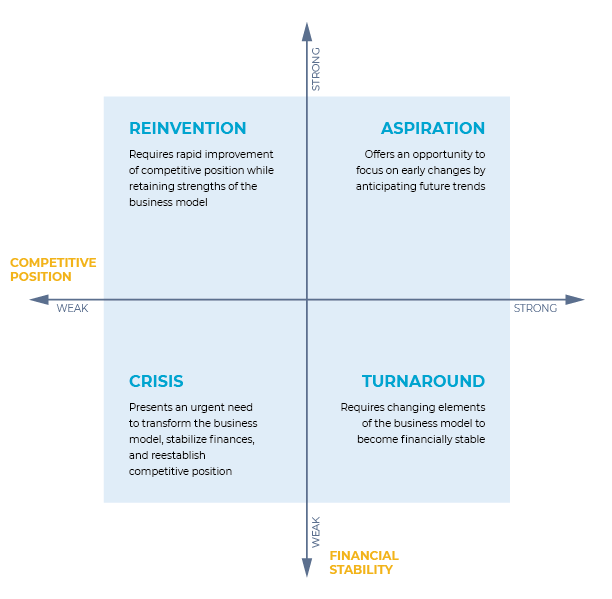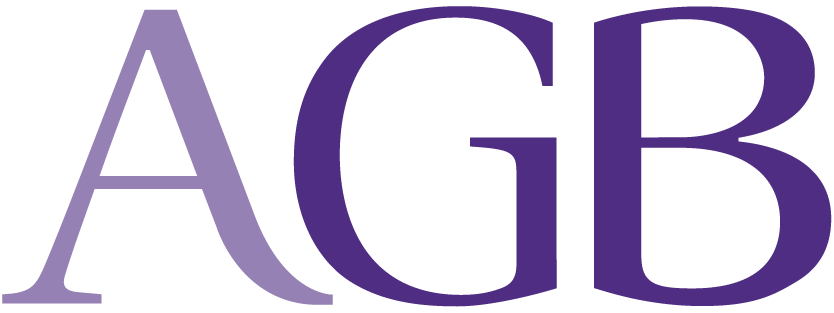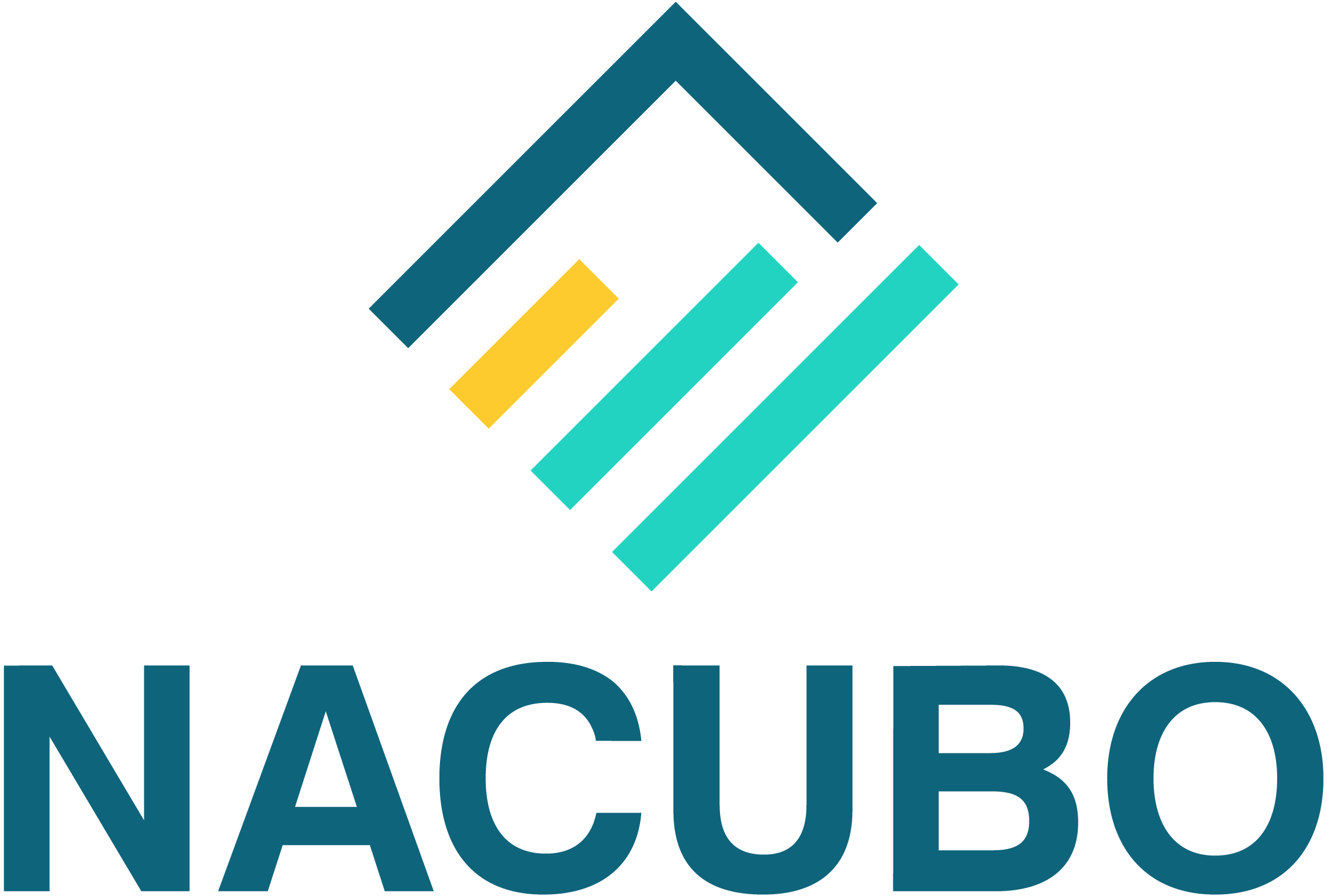Boardroom Conversations:
Have We Reached an Inflection Point?
Depending on the circumstances, a critical question institutional leaders may need to ask themselves is, “have we reached an inflection point?” The ultimate challenge for the governing board, president, and CFO is when the stress testing and benchmark data show significant variance from plan and signal material underlying business risk. AGB’s resource, “Unlocking the Power of Long-Term Strategic Alternatives,” offers a “situational awareness” assessment (see the matrix included below) that board members and leadership may need to consider when evaluating their institution’s current operating environment.1
The template is intended to offer governing boards and senior leadership the ability to ask critical questions to better comprehend the competitive positioning of an institution in times of disruption. It should help them identify which of their operating procedures and policies do not align with their existing market demographics and future trends. Moreover, the situational awareness matrix may help to facilitate internal discussions that can inform whether alternative actions are required to address the challenges the institution may be facing. Contingent upon the conclusions drawn from these discussions, the data and underlying results can help boards and senior leadership “formulate strategies, set goals, identify next steps, and establish timelines” to overcome the traditional institutional predisposition of maintaining the status quo.2 Furthermore, depending which quadrant institutional leadership finds themselves in, following a prescriptive business continuity planning process may have real utility for successfully implementing the chosen path forward.
Situational Awareness Matrix

Association of Governing Boards of Universities and Colleges, “Unlocking the Power of Long-Term Strategic Alternatives: A Resource for Boards and Institutional Leaders” (Washington, D.C.: Association of Governing Boards of Universities and Colleges, 2018), 24.
The value of following a business continuity planning process is not that it will stop bad things from happening, but rather it is the knowledge that an institution inevitably will face unexpected risks and the reassurance that it has taken proactive steps to put in place corrective actions to prepare for them. It is about building a culture of resiliency with the capacity to overcome adversity and having the institutional confidence to identify a credible path forward. It is particularly valuable in today’s higher education environment if and when leadership determines that staying the course is no longer a viable option. It provides a framework for management to work seamlessly to protect the long-term sustainability of the college or university. It provides the institution with a structure to engage stakeholders and build a collective understanding of the challenges and solutions that can move the organization forward. A process that offers a step-by-step approach to guiding institutional stakeholders into building a simple, but effective, plan to minimize long-term damage to the institution with the urgency necessary to return to “normal” operations after the risks are mitigated.3 A business continuity planning process that will nominally inform the college leadership’s discussions will take them through four major planning steps:
- Identification and assessment of institutional risks or threats;
- An understanding of the organizational impacts;
- Creating a multidimensional business continuity plan that responds to evolving market conditions; and
- Leadership training, testing, and plan maintenance to ensure relevance.4
If appropriately resourced and utilized successfully, this process will address each of the ten points outlined below and in EDUCAUSE’s Business Continuity and Disaster Recovery, which was drafted to help facilitate the organizational risk management conversation institutional leadership should have.5 Once a situational awareness assessment has identified and quantified the business risks facing the institution, the next challenge for governing boards and executive leadership when considering alternative strategies in periods of economic or operational crises is assessing when and how much risk to assume—that is, determining the institution’s “risk tolerance,” which is its own process.
“Often leaders on the journey of transformation struggle to embrace intelligent risk taking as an opportunity and competitive advantage, and rather get stuck in a status quo advocacy or barrier naming quagmire. The key to ensuring vitality is driving those high impact risk decisions.”
Christine Smith
Managing Director, Baker Tilly
As part of a business continuity planning process, when evaluating alternative program and/or project risk, institutional leadership must collectively consider both the “advantages” of pursuing a strategy or undertaking an activity (or not) and any embedded risk with the “disadvantages” of negative consequences that pursuing that strategy or activity (or not) may have on the institution’s long-term operational capabilities. Leadership, furthermore, will need to assess whether a proposed action (or inaction—that is, staying the course) offers a true competitive advantage—for instance, “intelligent risk taking”—or if its projected impact is more than outweighed by its potential downside.
This assessment is essential for leadership to find the necessary balance between the need to encourage the business innovation necessary for moving the institution forward juxtaposed with the need to mitigate or limit institutional risk exposure. By creating an environment that supports high-performing management teams, the governing board and senior leadership offer their institution a higher probability of success by promoting a culture of intelligent risk taking and innovation when the underlying business fundamentals supported by the data are signaling that change or transformation may be required.6
Business Continuity Planning Process
Know when to acknowledge that the issues are real.
Have the capacity to understand and assess the root causes for deviations from course.
Understand when to consider a midcourse correction.
Know when an incremental approach is not an option and be prepared to take decisive action.
Have the expertise to evaluate all options available to the college.
Be prepared to establish realistic remediation goals and objectives.
Communicate effectively and be transparent to keep stakeholders informed.
Honestly assess if alternative approaches are working in appropriate time frames.
Know when traditional solutions are no longer viable and extraordinary measures are required.
Have prepared the college to acknowledge and accept extraordinary measures are required.
EDUCAUSE, Business Continuity and Disaster Recovery 2018.
1 Association of Governing Boards of Universities and Colleges, “Unlocking the Power of Long-Term Strategic Alternatives: A Resource for Boards and Institutional Leaders” (Washington, D.C.: Association of Governing Boards of Universities and Colleges, 2018), 2, https://agb.org/tool/unlocking-the-power-of-long-term-strategic-alternatives/.
2 Association of Governing Boards, “Unlocking the Power,” 2.
3 Kuali, “A Thorough Guide to Continuity Planning in Higher Education,” Kuali Ready, https://www.kuali.co/resourcelp/rdy-a-thorough-guide-to-continuity-planning-in-higher-education.
4 Kuali, “A Thorough Guide to Continuity Planning.”
5 EDUCAUSE, Business Continuity and Disaster Recovery, https://www.educause.edu/focus-areas-and-initiatives/policy-and-security/cybersecurity-program/resources/information-security-guide/business-continuity-and-disaster-recovery.
6 Kin Ly, “4 alternative approaches to risk culture,” Risk Leadership Network, January 29, 2020.
Related Resources
Association of Governing Boards. “Assessing Financial Vitality Toolkit.” (Toolkit). https://agb.org/assessing-financial-vitality-toolkit/.








